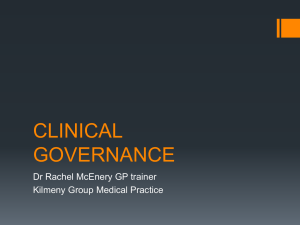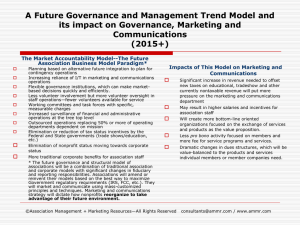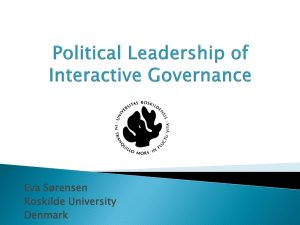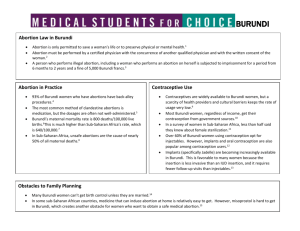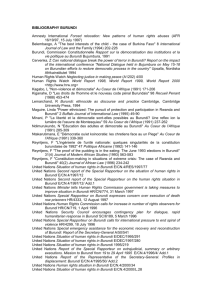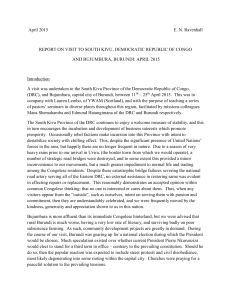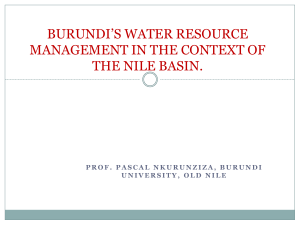Burundi Governance and Anti-Corruption Strategy
advertisement
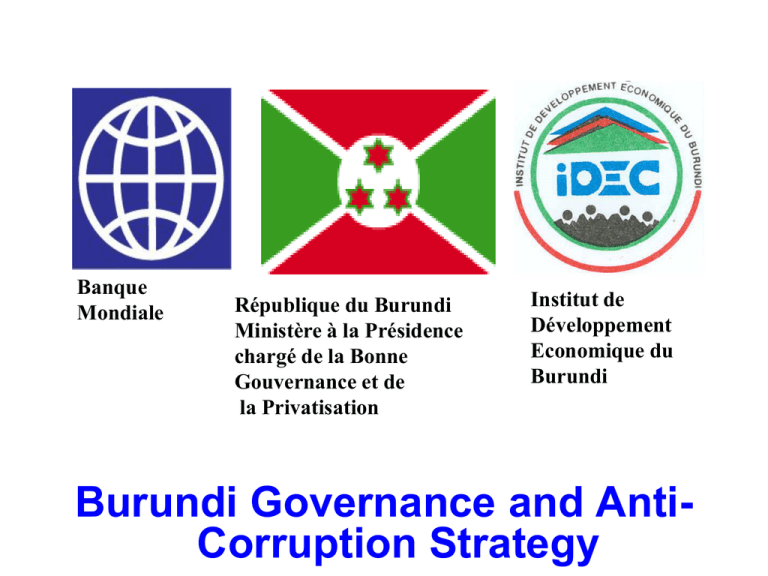
IDEC Banque Mondiale République du Burundi Ministère à la Présidence chargé de la Bonne Gouvernance et de la Privatisation Institut de Développement Economique du Burundi Burundi Governance and AntiCorruption Strategy I. The context 1. The country has been seriously damaged by a long civil war which stated in 1993. However, the conflict was accompanied by political negotiations which finally leaded to the Arusha Agreement for peace and Democracy in 2004. 2. From 2005, we have now a democratic Government that expressed political commitment to correct governance failures and fight against corruption. 3. In 2007, the Republic of Burundi’s President requested to the World Bank Institute to provide technical and financial support to carry out an assessment on the state of governace in the country. It was conducted through a participatory diagnostic survey of citizens, public sector officials, private and NGO sector employees (sample size around 3,500 ). I. The context (ctd 1) 1. In order to prepare the survey instruments , focus groups were conducted at the level of users and providers of public services in the capital Bujumbura and the province of Ngozi. 2. The national governance diagnostic survey aimed to obtain information on the experiences and perception on governance failures including corruption and their main causes and consequences. 3. The data collection was carried out by a polling firm (CERTI) based in Cotonou (Bénin). I. The context (ctd 2) 1. The dissemination of the results of the survey was a key component of the process. It was carried out through a series of workshops at national level, aiming at disseminating the findings but also at obtaining recommendations from participants for governance reform. 1. Dissemination of the results of the survey was also carried out through a series of radio programs targeting the marginalized youth in Burundi. The programmes included round table discussions wand allowed the youth to participate through the use of cell phones. II. Methodology of the Burundi National Governance and Anticorruption Strategy • Step one: operational • Step two: focus groups with main policy makers and main beneficiaries at Bujumbura (the capital of Burundi) Muramvya, and Bururi. • Step three: focus group with selected experts high skilled in Governance and anticorruption practices and studies II. Methodology of the Burundi National Governance and Anticorruption Strategy (Ctd 1) • Step for: Consultation with the Group of donors in the field of good governance and corruption fight • Step five: writing the Burundi Governance and Anticorruption Strategy to be submitted to the National Steering Committee. • In all those steps of the process, the World Bank Institute sent an expert (Susana Carrillo) to help in some technical issues. II. Methodology of the Burundi National Governance and Anticorruption Strategy (Ctd 2) The participatory process start by citizens who are essentially main beneficiaries, continues with policy makers and the groups of donors. The Government participated through the Steering Committee (representatives of different Ministries) which has to insure that the process in in accordance with the Terms of reference. III. General content of the Burundi Governance and anticorruption Strategy The strategy identifies strategic activities corresponding to main problems in three important sectors: socioeconomic sector, political and public administration sector, and the sector of peace, justice and security. However, there is one general, a political response, require on some transversal problems III.1. General strategic path • Establish incentives and promotion of leadership with positive long run vision and political spirit to promote good governance and to fight against corruption. III.2. Strategic actions in Socioeconomic sector • Strategic path 1. Counter the problem of resources mismanagement • Strategic path 2. Improving the living socio-economic conditions of officials • Strategic path 3. Strategic planning for economic development • Strategic path 4. Establish and / or strengthening at all levels, accountability mechanisms, access to information and accountability in managing public finances • Strategic path 5. Develop and make efficient mechanisms for monitoring and evaluation of planned activities at all levels. • Strategic path 6. Equity in resource allocation III.3. Strategic activities in political and public administration sector • Strategic path 7. Strengthen participatory democracy and strengthen the environment of peace, political and institutional stability. • Strategic path 8. Clarify, strengthen and institutionalize the framework of decentralization to encourage more citizen participation • Strategic path 9. Reinforce and respect the separation of powers for further law based government • Strategic path 10. Promoting fairness and transparency in access to employment • Strategic path 11. Promote the provision of quality public services • Strategic path 12. Reducing socio-professional conflicts within government III.4. Strategic activities in peace, justice and security sector • Strategic path 13. Strengthening mechanisms of law enforcement to curb all crimes impunity. • Strategic path 14. Strengthen the independence of judiciary to establish a law based Government • Strategic path 15. Strengthen mechanisms for protecting human rights to consolidate democracy and governance. • Strategic path 16. Consolidating peace agreements • Strategic path 17. Supporting the ongoing disarmament of civilians and fight against proliferation of small arms • Strategic path 18. Strengthen the professionalism of defence and security institutions to induce security governance and prevent devastating effects of their politization




